Music At Its Finest - Wells Milo Headphone Amplifier Review

Wells Milo is a high-end Headphone Amplifier, meant to fight with the best, and it will be compared against the Mytek Brooklyn DAC+, paired with the Young MK III from M2Tech, and also compared with iBasso DX220 + AMP7, and the Luxman P-750U Headphone Amplifier.
Introduction
Wells Adio is a company dealing with high-end audio components, and they live on the bleeding edge of precision and elegance, when it comes to designing an Amplifier, with utmost care to details, designing their own unique circuits and using the highest grade components available, to ensure the best sound for their customers. They will spend a good amount of time helping you choose the best product for you, and they will also provide very strong after sales service, including a long warranty, and will fix their own products a long time after they went out of warranty as well.
Overall, it feels like Wells Audio is a really good company to trust and work with, especially if you're looking to delight yourself with a high-end amplifier for your headphones.
It should be noted that I have absolutely no affiliation with Wells Audio. I'd like to thank Wells Audio for providing the sample for this review. This review reflects my personal experience with Wells Milo. Every opinion expressed is mine and I stand by it, the purpose of this review is to help those interested in Wells Milo find their next music companion.
About me
https://www.audiophile-heaven.com/p/about.html
Packaging
I didn't manage to get any photos of the package, but Wells Milo comes packaged really well in a cardboard box, with thick pieces of foam keeping it in place. There are no accessories to speak about, but it is a handmade headphone amplifier, so it doesn't really need much to work, except for cables, which you probably would want to have aftermarket solutions for anyways.
What to look in when purchasing a high-end Amplifier
https://www.audiophile-heaven.com/p/what-to-lookl.html
Technical Specifications
Output Power - 18 watts rms into 8 ohms at 1kHz with no more than .015% THD-12 watts rms into 32 ohms @ .006% THD-10 watts @46 ohms @.005% THD
Frequency Response - +/- 0.25 db from 16Hz to 30kHz
Signal To Noise Ratio - -94db at full power
Input Sensitivity - 0.72mV RMS
Gain - 30db (12db attenuator available, see below)
Input Impedance - 17k ohms
Output Impedance - 0.1 ohms
Damping Factor - 80, reference 8 ohms nominal
Power Consumption - 42 watts @ idle, 145 watts @ maximum power
Inputs - 1 pair RCAs, 1 pair XLRs optional (add $200.00)
Outputs - 1 x 4 pin stereo balanced connector, 1 1/4"stereo plug
Operating Voltage - 120 volt, 230 volt at 50 or 60 Hz
Shipping Dimensions - 16" x 12" x 12"
Shipping Weight - 10 lbs.
Dimensions - 8"w x 7.5"d x 9.75"h
Build Quality/Aesthetics/Functionality
Starting with the build quality, Milo is actually quite unique. This is the first Amplifier that I review in this shape, like a tall tower, with a smaller footprint on your desk, pretty different from most Amplifiers that are rectangular boxes that sit on your table. The feet are made of silicone, and Milo will not slide on your desk, especially since it is actually a bit heavy. The face of the unit is made of glass, and you can see parts of the electronics inside, and I actually had to take apart mine, so I will also add a few photos of the inner circuits.

The volume potentiometer on the front has a high number of adjustments, so you don't need to worry, you can always find you sweet spot, even if using IEMs. This being said, the Amplifier itself has, at maximum levels, just an insane amount of power. It is so crazy strong, that it feels like it was made for people who really want to either blow up their eardrums, or have a headphone that is really hard to drive, like the HIFIMAN He6SE.
The aesthetics of Milo are interesting, it has those wings like elements on the upper area of the unit. Those are heat dispersers and they do an amazing job, the unit never gets too hot, and since we're talking about one of the Amplifiers with the most driving power in the world, tested in mid Summer in Romania, this is a strong compliment.
You get your choice of XLR and RCA inputs, and since I had some time to play around, I tried using Milo with high-end cables, both for power and for its RCA connection. I have been using both Young MK III DAC from M2Tech, as well as other DACs to drive Milo, and I can only say I am impressed by how clean the overall power delivery is. This stays true for the Amplifier itself, it has a set of relays to protect your IEMs or Headphones, and it has a very low noise floor, and next to no hissing, having a pretty low output impedance.

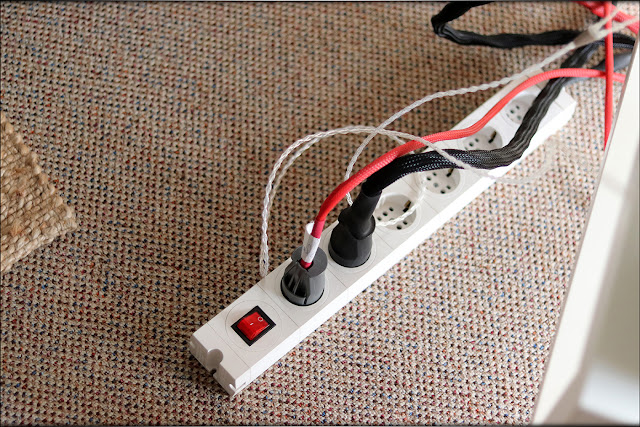
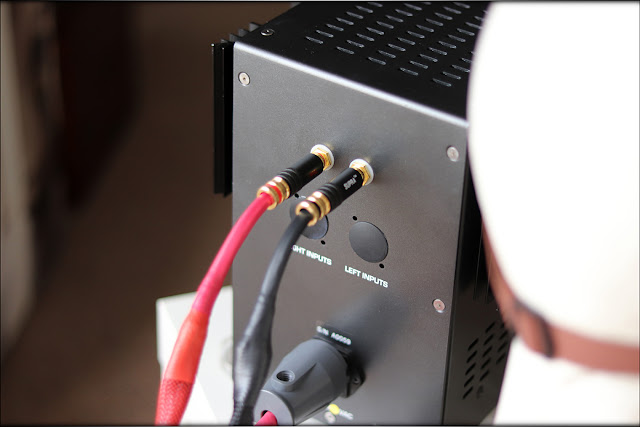

The functionality is simple, since there are no drivers implied, there's nothing else but the Amplifier itself, and the cables connecting it to the DAC and the headphones. I tried using Milo, using both its XLR and 6.3mm outputs, as I was curious about those, and both are really well designed. I can't say whether I like the sound of either more, they sound more or less the same to my ears, so you don't have to worry if you don't have the right cables for your headphones, both will work just fine.
While testing Milo together with a friend, I had the pleasure to hear more high-end Speakers and equipment, along with a large collection of Vinyl, making the whole experience quite unique for that day.




I could say that Milo is designed well, has a tank level of build quality, it is well thought for the enthusiast, and has a very simple, yet effective functionality, overall it is a top notch Headphone Amplifier.
Sound Quality
Here things start to get interesting, because Milo surely has a sound of its own.

The thing Milo does best, in my view, is that it combines the best of both worlds, tube and solid state amplifiers. It has that nice dampening factor that really gives headphones a beautiful sound, but it also has the speed and control of a proper solid state amplifier, basically, it combines the best of both worlds, in the end, managing to both make music beautiful, but also clear, detailed and precise.
The sound can be described as Fluid, Clean, Crisp, there is no trace of the typical grain you hear with most solid state amps, and even with some tube amps, the soundstage and layering are both top notch, and there is just a rich, organic kind of presentation, where you wonder how something can sound so natural. Milo is clearly not an analytical Amplifier, instead being musical and artistic about its job. The overall tonality is slightly thick, warm, with a smooth and lean top end, but with an organic and rich midrange that stands out as being musical.
The bass is what I'd call slightly elevated, the mid bass presence being slightly higher than what I'd call truly neutral. The fun part here is that the bass compliments every headphone I tried Milo with, and even headphones that would normally be pretty bassy, like the Verum One, or the Kennerton Thror, were complemented by how Milo handles bass. The attack speed is very good, and you can feel the bass rattle you, especially on the right music and at louder volumes, but more than anything Milo is a touch gentle, it won't deliver blows like your run of the mill solid state amplifier, it will instead be delicate.
The midrange is clearly where Milo truly shines, as it is so musical, clean, and rich, you just can't stop listening to it. If you've ever been to one of those concerts where they use top-of-the-shelf guitar amplifiers, and cabinets, you know what a truly beautiful guitar sound is like. Milo is even better, Milo is what I would call an overachiever in terms of midrange beauty. When it comes to its detail, Milo doesn't try to be analytical, it doesn't push the details in your face, but with a very detailed headphone like He6SE, you get everything you want, just, Milo in particular changes the way that monster sounds, from the good old HE6SE, which is known for its revealing abilities and crisp nature, Milo tones it down a bit, makes He6SE more smooth, more warm, and a touch more organic. There certainly is beauty to be heard with this combo, and what's more, with a headphone like the RAD-0, you can delve into an area previously not known to mankind, RAD-0 doesn't eat a ton of power, but they are simply musical, and when paired with Milo, they get to a whole new level of richness and fluidity. The fun part here is that the midrange doesn't feel viled or colored, it simply feels musical.
The treble is what I'd normally call a weak spot. If I had to find a weak spot in Milo, it would probably be the treble, but at the same time, I have a feeling you won't agree with me, and I have a feeling you may actually be interested in Milo exactly because of its treble, which is smooth, clean, but without grain and without fatigue. Of course, with a headphone like HE6SE, Milo manages to tone it down, and since I was using that one mostly for rock and metal, Milo making it easier doesn't necessarily suit my tastes, but for someone who wants a top end that is smooth and clean, to compliment that sub-bass extension and the rich midrange, Milo's like a true wonder. I know most people aren't considering getting a Milo to enjoy Metal, Death Metal or Anime-related music, and that's the thing, if you're purchasing Milo for Jazz, Classical or softer music, there's hardly anything that manages to be quite as well-rounded.

The soundstage is huge, just huge, even compared to Mytek Brooklyn DAC+, Milo manages to sound large and well-layered. I can hear the two competing for which is the widest, but they present the soundstage slightly different. Brooklyn DAC+ is much more into being holographic, but its slightly brighter tonal balance makes the soundstage and especially the air in the soundstage stand out more, while with Milo, you can hear an effortless huge stage, a large number of layers shining through your music. The dynamics are quite excellent, but like the entire nature of Milo, they aren't hard, like what you'd expect from something that would be super dynamic, or spastic, as I'd call it. I tend to enjoy really strong dynamics personally, but Milo managed to charm me with its more gentle and softer nature, where it has those dynamics, but it doesn't force them onto you, it simply plays the music as it should be played, without insisting that you hear it, but making sure that you enjoy it.
Desktop Usage
With Milo I have pretty few notes on its desktop usage. It has a very simple usage scenario, and well, that makes it very good for a desktop Amplifier. It doesn't really care for where you place it, as long as it is a practical location and as long as you still have access to the cables, and as long as you can plug your headphones in and change the volume, so you don't have to worry about placing it anywhere in particular.
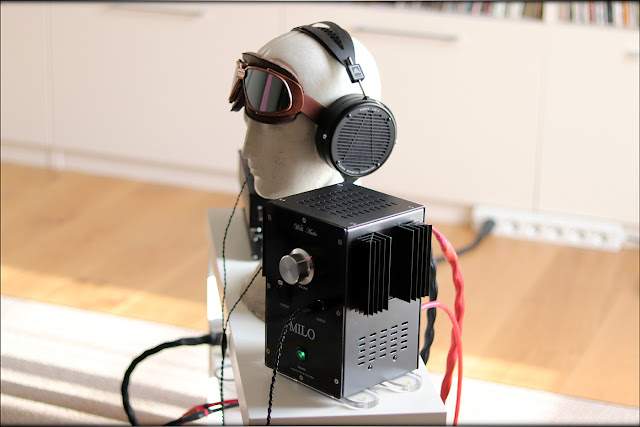




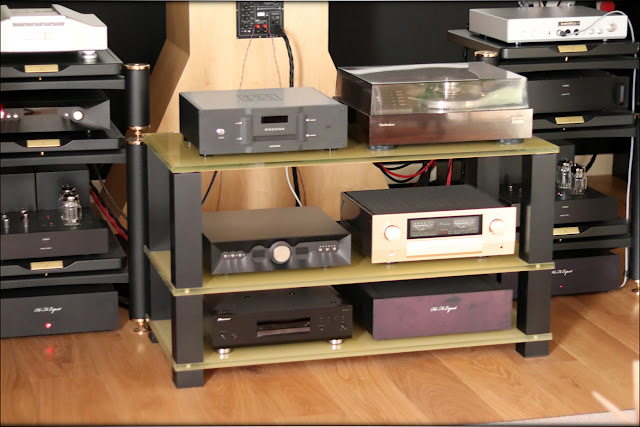

Although Milo has those wings on the corners, it doesn't really get hot, and quite frankly, it is a very well designed Amplifier. The combination of glass and metal may not suit everybody, and Milo surely makes a point about being a high-end amplifier with the overall design, but let's be honest about it, if you enjoy music in the way Milo presents it, you're most probably going to be alright with the aesthetics as well.
When it comes to the cables you're supposed to use with Milo, this is a conversation I won't take part in, I tested Milo with both cheap interconnects, and with high-end cables from a friend, and I could say that there are some differences, but since the two tests were done almost a day apart, I really really can't provide a reliable insight into this matter.
Milo will sit nicely on your table, it is heavy enough not to slide around, and the rubber feet provide an excellent grip, while the overall unit will probably pair nicely with any style. If anything, I think it is a happy fact that Milo has about the same footprint as most DACs out there, so you can easily stack it on top of a Young MK III DAC from M2 Tech, without having to worry about either breaking or heating up. I may be comparing Brooklyn DAC+ to Milo quite a lot, but if we're being honest about it, I have used the DAC+ more as a DAC to feed Milo than I can really count.
Overall, Milo is an excellent desktop Amplifier and you shouldn't have any issues using and enjoying it.
Comparisons
For the comparisons part of this review, I have chosen and will be comparing Milo to Mytek Brooklyn DAC+, Luxman P-750u, and iBasso DX220 + AMP7. I know the prices and the design of those devices isn't exactly the same, but I got a lot of requests to do those comparisons, especially because people are considering options that sometimes are different in design entirely, for example many folks using DX220 as the main DAC in their high-end system.
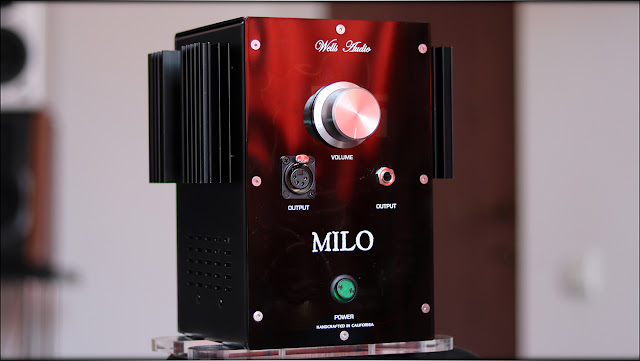
Wells Milo vs Luxman P750U - Why not start with an interesting comparison, I said to myself. It should be noted that I do not own the Luxman, and a friend let me use it for this review, so I won't be able to do a full in-depth review about it for the moment, but in the near future I may be planning to do an article on it, along with iFi's iPro series. Either way, when it comes to the sound, the P750u is more solid, has a tendency to also be organic and rich, but it is also brighter, with a stronger sparkle in the top end, without being harsh. The Luxman is better suited for metal music, and for those looking for a more impactful presentation, where Milo is more musical, softer, and more liquid. If anything, the Luxman is more detailed, but Milo surely sounds more lean and musical, easier to enjoy for the sake of listening to music, where the Luxman, technically superior, isn't quite as fluid as Milo, and it feels like I'm comparing the character of RAD-0 from Rosson, which would be the Milo, and the more analytic He6SE from HIFIMAN. I love both, but for very different reasons, and each works best for a certain scenario.
Wells Milo vs DX220 + AMP7 - So, why not compare Milo with a portable solution? I actually got a ton of requests for this comparison, probably because everyone noticed how much I like DX220 with AMP7, so it is time to see how the two compare. From the start, you're hit with a different tonal balance, AMP7 is actually rather analytic, bright-ish and kinda open in the upper midrange and the treble. AMP7 is not thick, and not very fluid either, and not very rich. The more I compare them, the more it feels like DX220 would be better used with its AMP9, which sounds tube-like, well, because it has real tubes inside. Either way, Milo feels thicker, more fluid, warmer, more organic, more rich and more musical in comparison. In terms of details, and I won't lie, I can't say which has better details, but I am not really searching for the utmost detail here, but for the most enjoyable of the two, and if you're listening to softer music, then Milo is surely going to hit a sweet spot for you.
Wells Milo vs Mytek Brooklyn DAC+ - Mytek Brooklyn DAC+ is a worthy opponent for Milo, because not only it has a very good price, and also has one of the best DACs around inside, but also has an excellent headphone output, being one of my favorites. The tonal balance is slightly different, both are detailed and clear, but Milo is more fluid, where DAC+ is more crispy. DAC+ feels more holographic, has more emphasis on the treble, where Milo is softer, has less grain, and sounds thicker, and warmer, but also less expanded spatially, where DAC+ feels like its soundstage is wider. In terms of details, they are comparable, but I feel that Milo has a touch more detail and clarity when compared directly, but that's not an issue, considering that Milo is just the Amplifier, and for this test I used DAC+ as the DAC for this system.
Pairing
Wells Milo pairs beautifully with anything, but for this review in particular I have chosen Kennerton Thror, HIFIMAN HE6SE, and Verum One as the main headphones I'll be pairing Milo with.

Wells Milo + HIFIMAN He6SE - This is one of the most interesting, and polarizing pairings, because He6SE has a very specific character that some loved in its default shape, a bit bright, very detailed, clean, and with a musical midrange, while some tried to change, to a more smooth and thick sound. The thing is, Milo actually changes the sound of HE6SE, and where with something like the Mytek Brooklyn DAC+, I would most of times hear a brighter, more punchy, harder and colder sound, with Milo HE6Se is warmer, smoother, more musical and has a much easier character. This compliments Jazz, Classical and other musical styles quite well, but it doesn't compliment Metal or Rock music quite that much, so you should make sure you're getting Milo for the right reasons.
Wells Milo + Verum One - Verum One is a headphone that's been loved and admired by many, and while we talk about it, it is a headphone that's really affordable. You could simply decide to get one, and just get one, but the surprises only begin after you decide to get a Verum One, because it scales beautifully with better amplifiers and DACs, and with Milo you can totally see what you'd want to call a perfect match, as Verum One not only sounds rich, they sound impactful and well controlled, the treble is soft-ish and ear-friendly, and with this pairing shines with literally any musical style.
Wells Milo + Kennrton Thror - Thror is a beautiful headphone both on the inside, as in, sonically, but also on the outside, the guys at Kennerton and Fischer Audio having designed something of true beauty and pleasing aesthetics. In terms of sound, this pairing is very fluid, clean, but also impactful and deep. The treble is pretty soft and easy, and the bass extents nicely in the sub-lows, where you can not only hear, but also feel how good Milo is at powerting the Thror, but then again, Thror doesn't require quite that much power, so you shouldn't be amazed that Milo drives them very well, and with ease.
Value and Conclusion
When we consider the value of Wells Milo, we start to take into account the design of it, and its real price. I have been reviewing the upgraded version, which includes the Khozmo, and which is priced at about 2200 USD. Overall, if you're looking for a top-of-the-shelf Headphone Amplifier (you can also use Milo as a Desktop Amplifier for your speakers, if you have speakers that require little power, like high-end ones), then Milo makes an excellent choice, especially if you grew bored with having to pick from the more harsh and hard nature of most Solid State Amplifiers, or the beautiful, yet sometimes muddy nature of Tube Amplifiers. Well, Milo manages to combine the best of both worlds, and to give you one of the most interesting Amplifiers for its money.

Starting with the package, there is almost no package to talk about, and Milo comes pretty naked, but you're most probably going to want to use your own selection of cables, and other accessories, so Milo surely is enough, and the bright side, it is well seated in its package, it is protected nicely during shipping, and I couldn't complain at all about the way it is presented, so the guys at Wells audio surely impressed me.
The aesthetics and build quality are also top notch, and the unit itself is serviceable, especially if you want to take a look inside, as I did during this review, so don't worry, an easily serviceable unit, combined with the skillful work of the guys at Wells Audio resulted in a very strong and well built Amplifier. It doesn't get hot, it doesn't bother while it is on your desk, and if you enjoy the aesthetic of Milo looking a bit like a device from a parallel universe, with those coolers that look like gills, then you're going to have a truly awesome time using it.
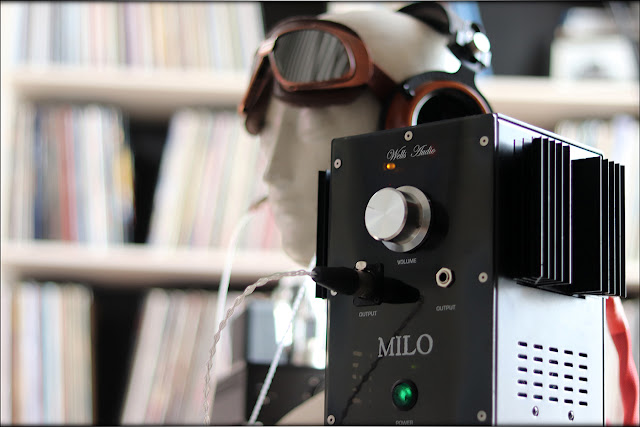
The sound is a gentle, clean, rich, organic one, that is different from what most people expect from an Amplifier in this price range. In fact, everything about Milo is slightly different that my personal expectations, Milo doesn't sound dry nor too crispy, but it isn't boomy nor too thick, it is what I'd call truly rich, organic and musical, Milo doesn't beg you to hear its technical ability, and Milo doesn't lag behind the competition, it simply plays music skillfully and with a soft side for the artistic.

Before reaching the final conclusion, Milo will enter Audiophile-Heaven's Hall Of Fame for providing music lovers from all over the world with a truly effortless device, one that plays music instead of analysing it, and a device that's made for your ears, and nothing else.

At the end of this review, if you are looking for an Amplifier that will manage to keep you entertained, an amplifier that has the power to drive any headphone under the sun, and which has both 6.3mm and XLR outputs, which has a very beautiful design, and which comes with a reliable warranty, you should totally consider Wells Milo as your next top-of-the-shelf Amplifier, as I'm quite sure it will bring a lot of fun to you!
Full Playlist used for this review
While we listened to considerably more songs than those named in this playlist, those are excellent for identifying certain aspects of the sound, like PRaT, Texturization, Detail, Resolution, Dynamics, Impact, and overall tonality. We recommend trying most of the songs from this playlist, especially if you're searching for new most, most of them being rather catchy.
Youtube Playlist
https://www.youtube.com/playlist?list=PL_cjBXGmwSHSdGcwuc_bKbBDGHL4QvYBu
Tidal Playlist
https://listen.tidal.com/playlist/64555551-ec3c-4279-ae44-248fdfcf6c4b
Song List
Bats - Gamma Ray Burst: Second Date
Eskimo Callboy - Frances
Incubus - Summer Romance
Electric Six - Dager! High Voltage
Kishida Cult - High School Of The Dead
Dimmu Borgir - Dimmu Borgir
Breaking Benjamin - I Will Not Bow
Thousand Foot Krutch - The Flame In All Of Us
Gorillaz - Feel Good Inc.
Infected Mushroom - Song Pong
Attack Attack - Kissed A Girl
Doctor P - Bulletproof
Maximum The Hormone - Rock n Roll Chainsaw
Rob Zombie - Werewolf, Baby!
Escape The Fate - Gorgeous Nightmare
SOAD - Chop Suey
Ken Ashcorp - Absolute Territory
Machinae Supremacy - Need For Steve
Ozzy Osbourne - I Don't Wanna Stop
Crow'sclaw - Loudness War
Eminem - Rap God
Stromae - Humain À L'eau
Sonata Arctica - My Selene
Justin Timberlake - Sexy Back
Metallica - Fuel
Veil Of Maya - Unbreakable
Masa Works - Golden Japang
REOL - Luvoratorrrrry
Dope - Addiction
Korn - Word Up!
Papa Roach - ... To be Loved
Fever The Ghost - Source
Fall Out Boy - Immortals
Green Day - Know The Enemy
Mindless Self Indulgence - London Bridge
A static Lullaby - Toxic
Royal Republic - Addictive
Astronautalis - The River, The Woods
We Came As Romans - My Love
Skillet - What I Believe
Man With A Mission - Smells Like Teen Spirit
Yasuda Rei - Mirror
Mojo Juju - Must Be Desire
Falling Up - Falling In Love
Manafest - Retro Love
Rodrigo Y Grabriela - Paris
Zomboy - Lights Out
Muse - Resistance
T.A.T.U & Rammstein - Mosaku
Grey Daze - Anything, Anything
Katy Perry - Who Am I Living For
Maroon 5 - Lucky Strike
Machinae Supremacy - Killer Instinct
Pendulum - Propane Nightmares
Sirenia - Lithium And A Lover
Saving Abel - Addicted
Hollywood Undead - Levitate
The Offspring - Special Delivery
Escape The Fate - Smooth
Samsara Blues Experiment - One With The Universe
Dope - Rebel Yell
Crazy Town - Butterfly
Silverstein - My Heroine
Memphis May Fire - Not Over Yet
I hope my review is helpful to you!
---
Contact me!





---

Wells Milo is a high-end Headphone Amplifier, meant to fight with the best, and it will be compared against the Mytek Brooklyn DAC+, paired with the Young MK III from M2Tech, and also compared with iBasso DX220 + AMP7, and the Luxman P-750U Headphone Amplifier.
Introduction
Wells Adio is a company dealing with high-end audio components, and they live on the bleeding edge of precision and elegance, when it comes to designing an Amplifier, with utmost care to details, designing their own unique circuits and using the highest grade components available, to ensure the best sound for their customers. They will spend a good amount of time helping you choose the best product for you, and they will also provide very strong after sales service, including a long warranty, and will fix their own products a long time after they went out of warranty as well.
Overall, it feels like Wells Audio is a really good company to trust and work with, especially if you're looking to delight yourself with a high-end amplifier for your headphones.
It should be noted that I have absolutely no affiliation with Wells Audio. I'd like to thank Wells Audio for providing the sample for this review. This review reflects my personal experience with Wells Milo. Every opinion expressed is mine and I stand by it, the purpose of this review is to help those interested in Wells Milo find their next music companion.
About me
https://www.audiophile-heaven.com/p/about.html
Packaging
I didn't manage to get any photos of the package, but Wells Milo comes packaged really well in a cardboard box, with thick pieces of foam keeping it in place. There are no accessories to speak about, but it is a handmade headphone amplifier, so it doesn't really need much to work, except for cables, which you probably would want to have aftermarket solutions for anyways.
What to look in when purchasing a high-end Amplifier
https://www.audiophile-heaven.com/p/what-to-lookl.html
Technical Specifications
Output Power - 18 watts rms into 8 ohms at 1kHz with no more than .015% THD-12 watts rms into 32 ohms @ .006% THD-10 watts @46 ohms @.005% THD
Frequency Response - +/- 0.25 db from 16Hz to 30kHz
Signal To Noise Ratio - -94db at full power
Input Sensitivity - 0.72mV RMS
Gain - 30db (12db attenuator available, see below)
Input Impedance - 17k ohms
Output Impedance - 0.1 ohms
Damping Factor - 80, reference 8 ohms nominal
Power Consumption - 42 watts @ idle, 145 watts @ maximum power
Inputs - 1 pair RCAs, 1 pair XLRs optional (add $200.00)
Outputs - 1 x 4 pin stereo balanced connector, 1 1/4"stereo plug
Operating Voltage - 120 volt, 230 volt at 50 or 60 Hz
Shipping Dimensions - 16" x 12" x 12"
Shipping Weight - 10 lbs.
Dimensions - 8"w x 7.5"d x 9.75"h
Build Quality/Aesthetics/Functionality
Starting with the build quality, Milo is actually quite unique. This is the first Amplifier that I review in this shape, like a tall tower, with a smaller footprint on your desk, pretty different from most Amplifiers that are rectangular boxes that sit on your table. The feet are made of silicone, and Milo will not slide on your desk, especially since it is actually a bit heavy. The face of the unit is made of glass, and you can see parts of the electronics inside, and I actually had to take apart mine, so I will also add a few photos of the inner circuits.

The volume potentiometer on the front has a high number of adjustments, so you don't need to worry, you can always find you sweet spot, even if using IEMs. This being said, the Amplifier itself has, at maximum levels, just an insane amount of power. It is so crazy strong, that it feels like it was made for people who really want to either blow up their eardrums, or have a headphone that is really hard to drive, like the HIFIMAN He6SE.
The aesthetics of Milo are interesting, it has those wings like elements on the upper area of the unit. Those are heat dispersers and they do an amazing job, the unit never gets too hot, and since we're talking about one of the Amplifiers with the most driving power in the world, tested in mid Summer in Romania, this is a strong compliment.
You get your choice of XLR and RCA inputs, and since I had some time to play around, I tried using Milo with high-end cables, both for power and for its RCA connection. I have been using both Young MK III DAC from M2Tech, as well as other DACs to drive Milo, and I can only say I am impressed by how clean the overall power delivery is. This stays true for the Amplifier itself, it has a set of relays to protect your IEMs or Headphones, and it has a very low noise floor, and next to no hissing, having a pretty low output impedance.




The functionality is simple, since there are no drivers implied, there's nothing else but the Amplifier itself, and the cables connecting it to the DAC and the headphones. I tried using Milo, using both its XLR and 6.3mm outputs, as I was curious about those, and both are really well designed. I can't say whether I like the sound of either more, they sound more or less the same to my ears, so you don't have to worry if you don't have the right cables for your headphones, both will work just fine.
While testing Milo together with a friend, I had the pleasure to hear more high-end Speakers and equipment, along with a large collection of Vinyl, making the whole experience quite unique for that day.




I could say that Milo is designed well, has a tank level of build quality, it is well thought for the enthusiast, and has a very simple, yet effective functionality, overall it is a top notch Headphone Amplifier.
Sound Quality
Here things start to get interesting, because Milo surely has a sound of its own.

The thing Milo does best, in my view, is that it combines the best of both worlds, tube and solid state amplifiers. It has that nice dampening factor that really gives headphones a beautiful sound, but it also has the speed and control of a proper solid state amplifier, basically, it combines the best of both worlds, in the end, managing to both make music beautiful, but also clear, detailed and precise.
The sound can be described as Fluid, Clean, Crisp, there is no trace of the typical grain you hear with most solid state amps, and even with some tube amps, the soundstage and layering are both top notch, and there is just a rich, organic kind of presentation, where you wonder how something can sound so natural. Milo is clearly not an analytical Amplifier, instead being musical and artistic about its job. The overall tonality is slightly thick, warm, with a smooth and lean top end, but with an organic and rich midrange that stands out as being musical.
The bass is what I'd call slightly elevated, the mid bass presence being slightly higher than what I'd call truly neutral. The fun part here is that the bass compliments every headphone I tried Milo with, and even headphones that would normally be pretty bassy, like the Verum One, or the Kennerton Thror, were complemented by how Milo handles bass. The attack speed is very good, and you can feel the bass rattle you, especially on the right music and at louder volumes, but more than anything Milo is a touch gentle, it won't deliver blows like your run of the mill solid state amplifier, it will instead be delicate.
The midrange is clearly where Milo truly shines, as it is so musical, clean, and rich, you just can't stop listening to it. If you've ever been to one of those concerts where they use top-of-the-shelf guitar amplifiers, and cabinets, you know what a truly beautiful guitar sound is like. Milo is even better, Milo is what I would call an overachiever in terms of midrange beauty. When it comes to its detail, Milo doesn't try to be analytical, it doesn't push the details in your face, but with a very detailed headphone like He6SE, you get everything you want, just, Milo in particular changes the way that monster sounds, from the good old HE6SE, which is known for its revealing abilities and crisp nature, Milo tones it down a bit, makes He6SE more smooth, more warm, and a touch more organic. There certainly is beauty to be heard with this combo, and what's more, with a headphone like the RAD-0, you can delve into an area previously not known to mankind, RAD-0 doesn't eat a ton of power, but they are simply musical, and when paired with Milo, they get to a whole new level of richness and fluidity. The fun part here is that the midrange doesn't feel viled or colored, it simply feels musical.
The treble is what I'd normally call a weak spot. If I had to find a weak spot in Milo, it would probably be the treble, but at the same time, I have a feeling you won't agree with me, and I have a feeling you may actually be interested in Milo exactly because of its treble, which is smooth, clean, but without grain and without fatigue. Of course, with a headphone like HE6SE, Milo manages to tone it down, and since I was using that one mostly for rock and metal, Milo making it easier doesn't necessarily suit my tastes, but for someone who wants a top end that is smooth and clean, to compliment that sub-bass extension and the rich midrange, Milo's like a true wonder. I know most people aren't considering getting a Milo to enjoy Metal, Death Metal or Anime-related music, and that's the thing, if you're purchasing Milo for Jazz, Classical or softer music, there's hardly anything that manages to be quite as well-rounded.

The soundstage is huge, just huge, even compared to Mytek Brooklyn DAC+, Milo manages to sound large and well-layered. I can hear the two competing for which is the widest, but they present the soundstage slightly different. Brooklyn DAC+ is much more into being holographic, but its slightly brighter tonal balance makes the soundstage and especially the air in the soundstage stand out more, while with Milo, you can hear an effortless huge stage, a large number of layers shining through your music. The dynamics are quite excellent, but like the entire nature of Milo, they aren't hard, like what you'd expect from something that would be super dynamic, or spastic, as I'd call it. I tend to enjoy really strong dynamics personally, but Milo managed to charm me with its more gentle and softer nature, where it has those dynamics, but it doesn't force them onto you, it simply plays the music as it should be played, without insisting that you hear it, but making sure that you enjoy it.
Desktop Usage
With Milo I have pretty few notes on its desktop usage. It has a very simple usage scenario, and well, that makes it very good for a desktop Amplifier. It doesn't really care for where you place it, as long as it is a practical location and as long as you still have access to the cables, and as long as you can plug your headphones in and change the volume, so you don't have to worry about placing it anywhere in particular.







Although Milo has those wings on the corners, it doesn't really get hot, and quite frankly, it is a very well designed Amplifier. The combination of glass and metal may not suit everybody, and Milo surely makes a point about being a high-end amplifier with the overall design, but let's be honest about it, if you enjoy music in the way Milo presents it, you're most probably going to be alright with the aesthetics as well.
When it comes to the cables you're supposed to use with Milo, this is a conversation I won't take part in, I tested Milo with both cheap interconnects, and with high-end cables from a friend, and I could say that there are some differences, but since the two tests were done almost a day apart, I really really can't provide a reliable insight into this matter.
Milo will sit nicely on your table, it is heavy enough not to slide around, and the rubber feet provide an excellent grip, while the overall unit will probably pair nicely with any style. If anything, I think it is a happy fact that Milo has about the same footprint as most DACs out there, so you can easily stack it on top of a Young MK III DAC from M2 Tech, without having to worry about either breaking or heating up. I may be comparing Brooklyn DAC+ to Milo quite a lot, but if we're being honest about it, I have used the DAC+ more as a DAC to feed Milo than I can really count.
Overall, Milo is an excellent desktop Amplifier and you shouldn't have any issues using and enjoying it.
Comparisons
For the comparisons part of this review, I have chosen and will be comparing Milo to Mytek Brooklyn DAC+, Luxman P-750u, and iBasso DX220 + AMP7. I know the prices and the design of those devices isn't exactly the same, but I got a lot of requests to do those comparisons, especially because people are considering options that sometimes are different in design entirely, for example many folks using DX220 as the main DAC in their high-end system.

Wells Milo vs Luxman P750U - Why not start with an interesting comparison, I said to myself. It should be noted that I do not own the Luxman, and a friend let me use it for this review, so I won't be able to do a full in-depth review about it for the moment, but in the near future I may be planning to do an article on it, along with iFi's iPro series. Either way, when it comes to the sound, the P750u is more solid, has a tendency to also be organic and rich, but it is also brighter, with a stronger sparkle in the top end, without being harsh. The Luxman is better suited for metal music, and for those looking for a more impactful presentation, where Milo is more musical, softer, and more liquid. If anything, the Luxman is more detailed, but Milo surely sounds more lean and musical, easier to enjoy for the sake of listening to music, where the Luxman, technically superior, isn't quite as fluid as Milo, and it feels like I'm comparing the character of RAD-0 from Rosson, which would be the Milo, and the more analytic He6SE from HIFIMAN. I love both, but for very different reasons, and each works best for a certain scenario.
Wells Milo vs DX220 + AMP7 - So, why not compare Milo with a portable solution? I actually got a ton of requests for this comparison, probably because everyone noticed how much I like DX220 with AMP7, so it is time to see how the two compare. From the start, you're hit with a different tonal balance, AMP7 is actually rather analytic, bright-ish and kinda open in the upper midrange and the treble. AMP7 is not thick, and not very fluid either, and not very rich. The more I compare them, the more it feels like DX220 would be better used with its AMP9, which sounds tube-like, well, because it has real tubes inside. Either way, Milo feels thicker, more fluid, warmer, more organic, more rich and more musical in comparison. In terms of details, and I won't lie, I can't say which has better details, but I am not really searching for the utmost detail here, but for the most enjoyable of the two, and if you're listening to softer music, then Milo is surely going to hit a sweet spot for you.
Wells Milo vs Mytek Brooklyn DAC+ - Mytek Brooklyn DAC+ is a worthy opponent for Milo, because not only it has a very good price, and also has one of the best DACs around inside, but also has an excellent headphone output, being one of my favorites. The tonal balance is slightly different, both are detailed and clear, but Milo is more fluid, where DAC+ is more crispy. DAC+ feels more holographic, has more emphasis on the treble, where Milo is softer, has less grain, and sounds thicker, and warmer, but also less expanded spatially, where DAC+ feels like its soundstage is wider. In terms of details, they are comparable, but I feel that Milo has a touch more detail and clarity when compared directly, but that's not an issue, considering that Milo is just the Amplifier, and for this test I used DAC+ as the DAC for this system.
Pairing
Wells Milo pairs beautifully with anything, but for this review in particular I have chosen Kennerton Thror, HIFIMAN HE6SE, and Verum One as the main headphones I'll be pairing Milo with.

Wells Milo + HIFIMAN He6SE - This is one of the most interesting, and polarizing pairings, because He6SE has a very specific character that some loved in its default shape, a bit bright, very detailed, clean, and with a musical midrange, while some tried to change, to a more smooth and thick sound. The thing is, Milo actually changes the sound of HE6SE, and where with something like the Mytek Brooklyn DAC+, I would most of times hear a brighter, more punchy, harder and colder sound, with Milo HE6Se is warmer, smoother, more musical and has a much easier character. This compliments Jazz, Classical and other musical styles quite well, but it doesn't compliment Metal or Rock music quite that much, so you should make sure you're getting Milo for the right reasons.
Wells Milo + Verum One - Verum One is a headphone that's been loved and admired by many, and while we talk about it, it is a headphone that's really affordable. You could simply decide to get one, and just get one, but the surprises only begin after you decide to get a Verum One, because it scales beautifully with better amplifiers and DACs, and with Milo you can totally see what you'd want to call a perfect match, as Verum One not only sounds rich, they sound impactful and well controlled, the treble is soft-ish and ear-friendly, and with this pairing shines with literally any musical style.
Wells Milo + Kennrton Thror - Thror is a beautiful headphone both on the inside, as in, sonically, but also on the outside, the guys at Kennerton and Fischer Audio having designed something of true beauty and pleasing aesthetics. In terms of sound, this pairing is very fluid, clean, but also impactful and deep. The treble is pretty soft and easy, and the bass extents nicely in the sub-lows, where you can not only hear, but also feel how good Milo is at powerting the Thror, but then again, Thror doesn't require quite that much power, so you shouldn't be amazed that Milo drives them very well, and with ease.
Value and Conclusion
When we consider the value of Wells Milo, we start to take into account the design of it, and its real price. I have been reviewing the upgraded version, which includes the Khozmo, and which is priced at about 2200 USD. Overall, if you're looking for a top-of-the-shelf Headphone Amplifier (you can also use Milo as a Desktop Amplifier for your speakers, if you have speakers that require little power, like high-end ones), then Milo makes an excellent choice, especially if you grew bored with having to pick from the more harsh and hard nature of most Solid State Amplifiers, or the beautiful, yet sometimes muddy nature of Tube Amplifiers. Well, Milo manages to combine the best of both worlds, and to give you one of the most interesting Amplifiers for its money.

Starting with the package, there is almost no package to talk about, and Milo comes pretty naked, but you're most probably going to want to use your own selection of cables, and other accessories, so Milo surely is enough, and the bright side, it is well seated in its package, it is protected nicely during shipping, and I couldn't complain at all about the way it is presented, so the guys at Wells audio surely impressed me.
The aesthetics and build quality are also top notch, and the unit itself is serviceable, especially if you want to take a look inside, as I did during this review, so don't worry, an easily serviceable unit, combined with the skillful work of the guys at Wells Audio resulted in a very strong and well built Amplifier. It doesn't get hot, it doesn't bother while it is on your desk, and if you enjoy the aesthetic of Milo looking a bit like a device from a parallel universe, with those coolers that look like gills, then you're going to have a truly awesome time using it.

The sound is a gentle, clean, rich, organic one, that is different from what most people expect from an Amplifier in this price range. In fact, everything about Milo is slightly different that my personal expectations, Milo doesn't sound dry nor too crispy, but it isn't boomy nor too thick, it is what I'd call truly rich, organic and musical, Milo doesn't beg you to hear its technical ability, and Milo doesn't lag behind the competition, it simply plays music skillfully and with a soft side for the artistic.

Before reaching the final conclusion, Milo will enter Audiophile-Heaven's Hall Of Fame for providing music lovers from all over the world with a truly effortless device, one that plays music instead of analysing it, and a device that's made for your ears, and nothing else.

At the end of this review, if you are looking for an Amplifier that will manage to keep you entertained, an amplifier that has the power to drive any headphone under the sun, and which has both 6.3mm and XLR outputs, which has a very beautiful design, and which comes with a reliable warranty, you should totally consider Wells Milo as your next top-of-the-shelf Amplifier, as I'm quite sure it will bring a lot of fun to you!
Full Playlist used for this review
While we listened to considerably more songs than those named in this playlist, those are excellent for identifying certain aspects of the sound, like PRaT, Texturization, Detail, Resolution, Dynamics, Impact, and overall tonality. We recommend trying most of the songs from this playlist, especially if you're searching for new most, most of them being rather catchy.
Youtube Playlist
https://www.youtube.com/playlist?list=PL_cjBXGmwSHSdGcwuc_bKbBDGHL4QvYBu
Tidal Playlist
https://listen.tidal.com/playlist/64555551-ec3c-4279-ae44-248fdfcf6c4b
Song List
Bats - Gamma Ray Burst: Second Date
Eskimo Callboy - Frances
Incubus - Summer Romance
Electric Six - Dager! High Voltage
Kishida Cult - High School Of The Dead
Dimmu Borgir - Dimmu Borgir
Breaking Benjamin - I Will Not Bow
Thousand Foot Krutch - The Flame In All Of Us
Gorillaz - Feel Good Inc.
Infected Mushroom - Song Pong
Attack Attack - Kissed A Girl
Doctor P - Bulletproof
Maximum The Hormone - Rock n Roll Chainsaw
Rob Zombie - Werewolf, Baby!
Escape The Fate - Gorgeous Nightmare
SOAD - Chop Suey
Ken Ashcorp - Absolute Territory
Machinae Supremacy - Need For Steve
Ozzy Osbourne - I Don't Wanna Stop
Crow'sclaw - Loudness War
Eminem - Rap God
Stromae - Humain À L'eau
Sonata Arctica - My Selene
Justin Timberlake - Sexy Back
Metallica - Fuel
Veil Of Maya - Unbreakable
Masa Works - Golden Japang
REOL - Luvoratorrrrry
Dope - Addiction
Korn - Word Up!
Papa Roach - ... To be Loved
Fever The Ghost - Source
Fall Out Boy - Immortals
Green Day - Know The Enemy
Mindless Self Indulgence - London Bridge
A static Lullaby - Toxic
Royal Republic - Addictive
Astronautalis - The River, The Woods
We Came As Romans - My Love
Skillet - What I Believe
Man With A Mission - Smells Like Teen Spirit
Yasuda Rei - Mirror
Mojo Juju - Must Be Desire
Falling Up - Falling In Love
Manafest - Retro Love
Rodrigo Y Grabriela - Paris
Zomboy - Lights Out
Muse - Resistance
T.A.T.U & Rammstein - Mosaku
Grey Daze - Anything, Anything
Katy Perry - Who Am I Living For
Maroon 5 - Lucky Strike
Machinae Supremacy - Killer Instinct
Pendulum - Propane Nightmares
Sirenia - Lithium And A Lover
Saving Abel - Addicted
Hollywood Undead - Levitate
The Offspring - Special Delivery
Escape The Fate - Smooth
Samsara Blues Experiment - One With The Universe
Dope - Rebel Yell
Crazy Town - Butterfly
Silverstein - My Heroine
Memphis May Fire - Not Over Yet
I hope my review is helpful to you!
---
Contact me!





---





